The evolution of expected schooling in Brazil in the 20th century
DOI:
https://doi.org/10.1590/S1517-97022012005000005Keywords:
Secondary education, Expected schooling, Years of completed schoolingAbstract
This work presents two procedures to calculate the number of years of schooling afforded by the Brazilian education system. One of the procedures is based on the rates of completion at fundamental, secondary and higher education. This procedure, which relies on knowledge of the population distribution across several age groups and on the number of graduates at each education level, was used in the estimates related to the period before 1962. The other procedure is based on the number of years of schooling declared by the adult population, made available by the Brazilian Institute of Geography and Statistics (IBGE), and was employed to estimate the number of years of schooling achieved by the education system in earlier periods. The good agreement between the results obtained with the two methods for the period between 1962 and 1999 demonstrates that they are consistent. The combination of the two procedures can give the results for a period of around 90 years, starting in the mid-1920s. The uncertainties of the results estimated both from fluctuations in the data used and from the numerical approximations made, are around 3%. Some of the details of the calculations are presented at the end of the work, in appendixes. The variations in the number of years of schooling, when larger than the uncertainties estimated, are associated to political, social or educational events that characterize the historical period analyzed.Downloads
Download data is not yet available.
Downloads
Published
2012-03-01
Issue
Section
Articles
License
Authors assume exclusive responsibility for the concepts expressed in their articles, which do not necessarily reflect the journal’s opinion.
Permission to photocopy all or part of the material published in the journal is granted provided that the original source of publication be assigned.
How to Cite
The evolution of expected schooling in Brazil in the 20th century . (2012). Educação E Pesquisa, 38(1), 197-216. https://doi.org/10.1590/S1517-97022012005000005



